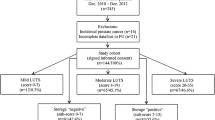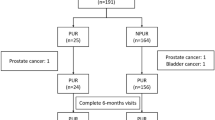Abstract
Purpose
To investigate the effect of metabolic syndrome (MS) on patient outcomes who underwent holmium laser enucleation of the prostate (HoLEP) for benign prostatic obstruction.
Materials and methods
Data from 151 patients who underwent HoLEP by a single surgeon between March 2012 and March 2016 were retrospectively analyzed. Patients with MS were assigned to group 1 (n = 33) and patients without MS in group 2 (n = 118). Clinical characteristics and the International Prostate Symptom Score (IPSS), including quality of life (QoL), peak urinary flow rate (Qmax), and postvoid residual urine (PVR), before surgery and 3 months afterward were compared between groups. Additionally, predictors of total IPSS improvement after HoLEP were assessed.
Results
Compared with group 2 patients, group 1 patients were older (70.3 vs. 65.2 years old, p = 0.001). Preoperative data, which included prostate volume, QoL, Qmax, and PVR, were not different between groups. For all patients, both the storage subscore and voiding subscore significantly decreased after surgery (p < 0.001). Postoperative total IPSS and voiding subscore improvement in group 1 were lower than in group 2 (total IPSS improvement 9.2 vs. 12.5, p = 0.042; voiding subscore improvement 6.6 vs. 8.8, p = 0.048). Multivariate analysis showed preoperative total IPSS (β = 0.79, CI 0.71–0.94, p < 0.001) and number of MS components (β = −0.15, CI −2.04 to −0.29, p = 0.009) were independently associated with total IPSS improvement.
Conclusions
We found that MS was associated with decreased postoperative symptom improvement. Thus, lower urinary tract symptoms after surgery may be a systemic disorder due to multiple metabolic risk factors.
Similar content being viewed by others
References
Yoo TK, Cho HJ (2012) Benign prostatic hyperplasia: from bench to clinic. Korean J Urol 53:139–148. doi:10.4111/kju.2012.53.3.139
Sener NC, Zengin K, Ozturk U et al (2015) The impact of metabolic syndrome on the outcomes of transurethral resection of the prostate. J Endourol Endourol Soc 29:340–343. doi:10.1089/end.2014.0562
Platz EA, Joshu CE, Mondul AM, Peskoe SB, Willett WC, Giovannucci E (2012) Incidence and progression of lower urinary tract symptoms in a large prospective cohort of United States men. J Urol 188:496–501. doi:10.1016/j.juro.2012.03.125
Ford ES, Giles WH, Dietz WH (2002) Prevalence of the metabolic syndrome among US adults: findings from the third National Health and Nutrition Examination Survey. JAMA 287:356–359
Expert Panel on Detection E, Treatment of High Blood Cholesterol in A (2001) Executive summary of the Third Report of The National Cholesterol Education Program (NCEP) expert panel on detection, evaluation, and treatment of high blood cholesterol in adults (Adult Treatment Panel III). JAMA 285:2486–2497
Jeong IG, Kang T, Bang JK et al (2011) Association between metabolic syndrome and the presence of kidney stones in a screened population. Am J Kidney Dis Off J Natl Kidney Found 58:383–388. doi:10.1053/j.ajkd.2011.03.021
Hammarsten J, Hogstedt B, Holthuis N, Mellstrom D (1998) Components of the metabolic syndrome-risk factors for the development of benign prostatic hyperplasia. Prostate Cancer Prostatic Dis 1:157–162. doi:10.1038/sj.pcan.4500221
Esposito K, Giugliano F, Martedi E et al (2005) High proportions of erectile dysfunction in men with the metabolic syndrome. Diabetes Care 28:1201–1203
Park YW, Kim SB, Kwon H et al (2013) The relationship between lower urinary tract symptoms/benign prostatic hyperplasia and the number of components of metabolic syndrome. Urology 82:674–679. doi:10.1016/j.urology.2013.03.047
Cyrus A, Kabir A, Goodarzi D et al (2014) Impact of metabolic syndrome on response to medical treatment of benign prostatic hyperplasia. Korean J Urol 55:814–820. doi:10.4111/kju.2014.55.12.814
McConnell JD, Roehrborn CG, Bautista OM et al (2003) The long-term effect of doxazosin, finasteride, and combination therapy on the clinical progression of benign prostatic hyperplasia. N Engl J Med 349:2387–2398. doi:10.1056/NEJMoa030656
Johnsen NV, Kammann TJ, Marien T, Pickens RB, Miller NL (2016) Comparison of holmium laser prostate enucleation outcomes in patients with or without preoperative urinary retention. J Urol 195:1021–1026. doi:10.1016/j.juro.2015.10.116
McVary KT, Roehrborn CG, Avins AL et al (2011) Update on AUA guideline on the management of benign prostatic hyperplasia. J Urol 185:1793–1803. doi:10.1016/j.juro.2011.01.074
Grundy SM, Cleeman JI, Daniels SR et al (2005) Diagnosis and management of the metabolic syndrome: an American Heart Association/National Heart, Lung, and Blood Institute Scientific Statement. Circulation 112:2735–2752. doi:10.1161/CIRCULATIONAHA.105.169404
Michel MC, Mehlburger L, Schumacher H, Bressel HU, Goepel M (2000) Effect of diabetes on lower urinary tract symptoms in patients with benign prostatic hyperplasia. J Urol 163:1725–1729
Michel MC, Heemann U, Schumacher H, Mehlburger L, Goepel M (2004) Association of hypertension with symptoms of benign prostatic hyperplasia. J Urol 172:1390–1393
Parsons JK, Bergstrom J, Barrett-Connor E (2008) Lipids, lipoproteins and the risk of benign prostatic hyperplasia in community-dwelling men. BJU Int 101:313–318. doi:10.1111/j.1464-410X.2007.07332.x
Martin S, Lange K, Haren MT, Taylor AW, Wittert G, Members of the Florey Adelaide Male Ageing S (2014) Risk factors for progression or improvement of lower urinary tract symptoms in a prospective cohort of men. The Journal of urology 191:130–137. doi:10.1016/j.juro.2013.06.018
Rohrmann S, Smit E, Giovannucci E, Platz EA (2005) Association between markers of the metabolic syndrome and lower urinary tract symptoms in the Third National Health and Nutrition Examination Survey (NHANES III). Int J Obes 29:310–316. doi:10.1038/sj.ijo.0802881
Park HK, Lee HW, Lee KS et al (2008) Relationship between lower urinary tract symptoms and metabolic syndrome in a community-based elderly population. Urology 72:556–560. doi:10.1016/j.urology.2008.03.043
McVary K (2006) Lower urinary tract symptoms and sexual dysfunction: epidemiology and pathophysiology. BJU Int 97(2):23–28. doi:10.1111/j.1464-410X.2006.06102.x (discussion 44–25)
Fukata Y, Amano M, Kaibuchi K (2001) Rho–Rho-kinase pathway in smooth muscle contraction and cytoskeletal reorganization of non-muscle cells. Trends Pharmacol Sci 22:32–39
Liu PY, Chen JH, Lin LJ, Liao JK (2007) Increased Rho kinase activity in a Taiwanese population with metabolic syndrome. J Am Coll Cardiol 49:1619–1624. doi:10.1016/j.jacc.2006.12.043
Rees RW, Foxwell NA, Ralph DJ, Kell PD, Moncada S, Cellek S (2003) Y-27632, a Rho-kinase inhibitor, inhibits proliferation and adrenergic contraction of prostatic smooth muscle cells. J Urol 170:2517–2522. doi:10.1097/01.ju.0000085024.47406.6c
Russo GI, Cimino S, Morgia G (2015) Benign prostatic hyperplasia and metabolic syndrome: the expanding evidences of a new disease of aging male. Aging Male Off J Int Soc Study Aging Male 18:133–134. doi:10.3109/13685538.2015.1028353
Vignozzi L, Rastrelli G, Corona G, Gacci M, Forti G, Maggi M (2014) Benign prostatic hyperplasia: a new metabolic disease? J Endocrinol Investig 37:313–322. doi:10.1007/s40618-014-0051-3
De Nunzio C, Cindolo L, Gacci M et al (2014) Metabolic syndrome and lower urinary tract symptoms in patients with benign prostatic enlargement: a possible link to storage symptoms. Urology 84:1181–1187. doi:10.1016/j.urology.2014.07.018
Kirby MG, Wagg A, Cardozo L et al (2010) Overactive bladder: is there a link to the metabolic syndrome in men? Neurourol Urodyn 29:1360–1364. doi:10.1002/nau.20892
Steers WD, Clemow DB, Persson K, Sherer TB, Andersson KE, Tuttle JB (1999) The spontaneously hypertensive rat: insight into the pathogenesis of irritative symptoms in benign prostatic hyperplasia and young anxious males. Exp Physiol 84:137–147
Pashootan P, Ploussard G, Cocaul A, de Gouvello A, Desgrandchamps F (2015) Association between metabolic syndrome and severity of lower urinary tract symptoms (LUTS): an observational study in a 4666 European men cohort. BJU Int 116:124–130. doi:10.1111/bju.12931
WHO/IASO/IOTF (2000) The Asia-Pacific perspective: redefining obesity and its treatment. Health Communications Australia, Melbourne
Author information
Authors and Affiliations
Corresponding author
Ethics declarations
Conflict of interest
The authors have no conflict of interest or financial disclosures to declare.
Rights and permissions
About this article
Cite this article
Kwon, T., Park, S., Park, S. et al. Metabolic syndrome is predictive of lower urinary tract symptom improvement after holmium laser enucleation of the prostate for benign prostatic obstruction. Int Urol Nephrol 49, 1105–1110 (2017). https://doi.org/10.1007/s11255-017-1580-4
Received:
Accepted:
Published:
Issue Date:
DOI: https://doi.org/10.1007/s11255-017-1580-4




